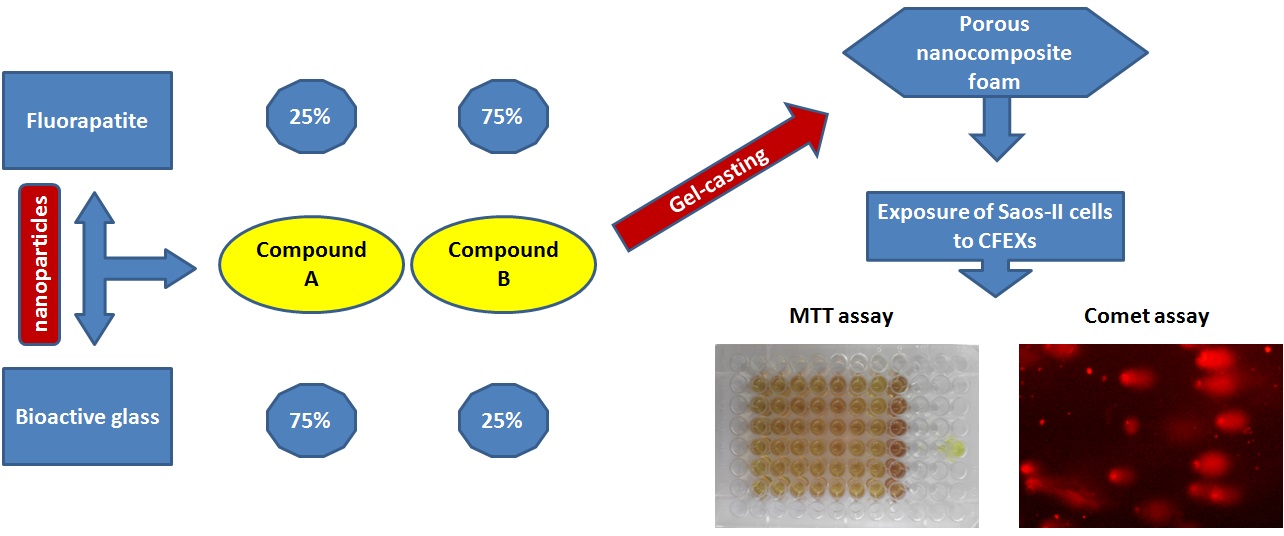Wed, Nov 27, 2024
[Archive]
Volume 19, Issue 4 (Desember 2022)
IJMSE 2022, 19(4): 1-10 |
Back to browse issues page
Download citation:
BibTeX | RIS | EndNote | Medlars | ProCite | Reference Manager | RefWorks
Send citation to:



BibTeX | RIS | EndNote | Medlars | ProCite | Reference Manager | RefWorks
Send citation to:
Zabihi E, Pourbagher R, Seyedmajidi S. Cytotoxicity and Genotoxicity Evaluation of Fluorapatite/bioactive Glass Nanocomposite Foams With Two Various Weight Ratios as Bone Tissue Scaffold: an in vitro study. IJMSE 2022; 19 (4) :1-10
URL: http://ijmse.iust.ac.ir/article-1-2692-en.html
URL: http://ijmse.iust.ac.ir/article-1-2692-en.html
Abstract: (7967 Views)
The optimization of biomaterials biodegradation rate similar to tissue regeneration, is one of the main
goals in the field of tissue engineering. However, the necessity to assess their possible toxicity is always considered.
The aim of this study was cytotoxicity and genotoxicity evaluation of fluorapatite/bioactive glass (FA/BG)
nanocomposite foams with two various weight ratios to determine the optimal composition. Nanocomposite foams
were made by gel-casting method with FA and BG as precursors in two weight ratios (A and B). Nanocomposite
foam extracts (CFEX) were prepared by shaking 100 mg/mL of each foam in a complete culture medium for 72 h in
a shaker incubator at 120 rpm/37ºC. Saos-II cells were exposed to different concentrations of CFEXs for 24 and
48 h and then cytotoxicity and genotoxicity were evaluated by MTT and comet assay, respectively. Based on the MTT
assay results after 24 h exposure, CFEX A at concentrations ≥75% and CFEX B at concentrations ≥50% had a
cytotoxic effect, while after 48 h, both CFEXs showed similar cytotoxicity at concentrations ≥25%. According to the
result of the comet assay, DNA damage increased with the increase of CFEXs concentration and exposure time.
Both CFEXs showed significantly higher comet tails elongation scores at concentrations ≥50% and ≥25% after 24
and 48 h exposure, respectively. Both composite foams could be considered as a non-toxic candidate for tissue
engineering at concentrations <25% which was less than FA50%/BG50% composite. Therefore, the composite with
equal FA/BG proportion has priority if similar results are obtained in in vivo complementary experiments.
goals in the field of tissue engineering. However, the necessity to assess their possible toxicity is always considered.
The aim of this study was cytotoxicity and genotoxicity evaluation of fluorapatite/bioactive glass (FA/BG)
nanocomposite foams with two various weight ratios to determine the optimal composition. Nanocomposite foams
were made by gel-casting method with FA and BG as precursors in two weight ratios (A and B). Nanocomposite
foam extracts (CFEX) were prepared by shaking 100 mg/mL of each foam in a complete culture medium for 72 h in
a shaker incubator at 120 rpm/37ºC. Saos-II cells were exposed to different concentrations of CFEXs for 24 and
48 h and then cytotoxicity and genotoxicity were evaluated by MTT and comet assay, respectively. Based on the MTT
assay results after 24 h exposure, CFEX A at concentrations ≥75% and CFEX B at concentrations ≥50% had a
cytotoxic effect, while after 48 h, both CFEXs showed similar cytotoxicity at concentrations ≥25%. According to the
result of the comet assay, DNA damage increased with the increase of CFEXs concentration and exposure time.
Both CFEXs showed significantly higher comet tails elongation scores at concentrations ≥50% and ≥25% after 24
and 48 h exposure, respectively. Both composite foams could be considered as a non-toxic candidate for tissue
engineering at concentrations <25% which was less than FA50%/BG50% composite. Therefore, the composite with
equal FA/BG proportion has priority if similar results are obtained in in vivo complementary experiments.
Type of Study: Research Paper |
Subject:
Parameter/material optimisation for tailoring the properties of prints
Send email to the article author
| Rights and permissions | |
 |
This work is licensed under a Creative Commons Attribution-NonCommercial 4.0 International License. |







